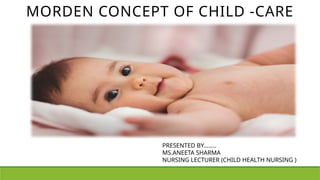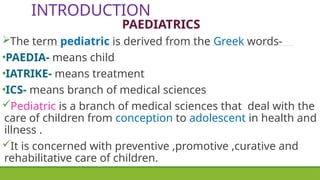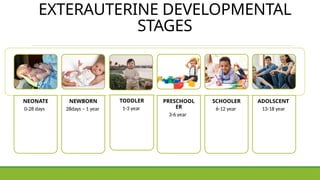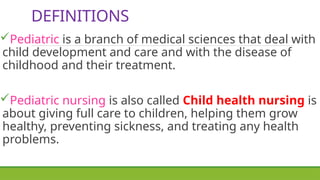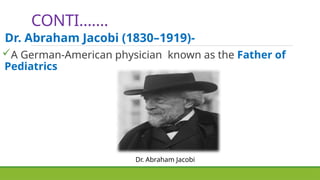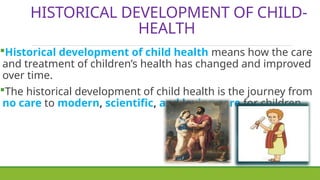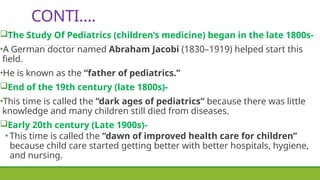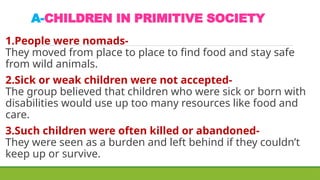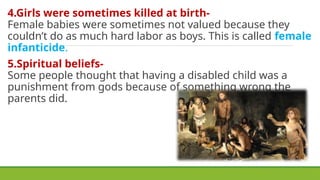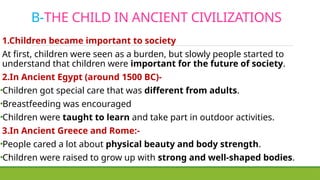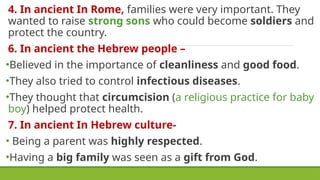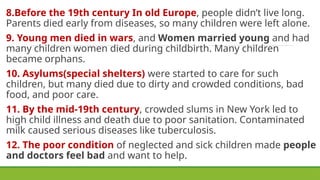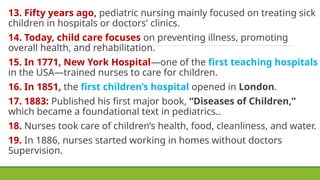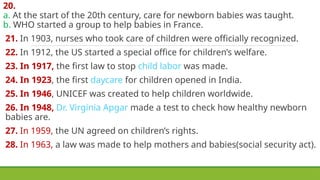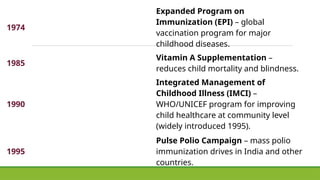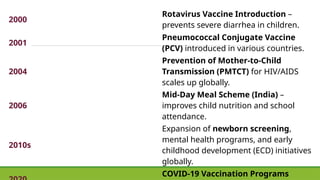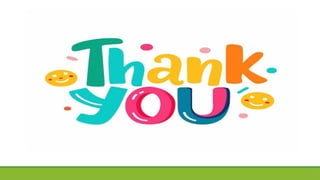Introduction to pediatric nursing in 5th Sem..pptx
- 1. MORDEN CONCEPT OF CHILD -CARE PRESENTED BY…….. MS.ANEETA SHARMA NURSING LECTURER (CHILD HEALTH NURSING )
- 2. INTRODUCTION PAEDIATRICS The term pediatric is derived from the Greek words- •PAEDIA- means child •IATRIKE- means treatment •ICS- means branch of medical sciences Pediatric is a branch of medical sciences that deal with the care of children from conception to adolescent in health and illness . It is concerned with preventive ,promotive ,curative and rehabilitative care of children.
- 3. INTRAUTERINE DEVELOVMENTAL STAGES CONCEPTIO N FERTILIZATIO N ZYGOATE 0-14 days EMBRYO 3-week - 8week FOETUS 9-week –till birth
- 4. EXTERAUTERINE DEVELOPMENTAL STAGES NEONATE 0-28 days NEWBORN 28days – 1 year TODDLER 1-3 year PRESCHOOL ER 3-6 year SCHOOLER 6-12 year ADOLSCENT 13-18 year
- 5. DEFINITIONS Pediatric is a branch of medical sciences that deal with child development and care and with the disease of childhood and their treatment. Pediatric nursing is also called Child health nursing is about giving full care to children, helping them grow healthy, preventing sickness, and treating any health problems.
- 6. CONTI……. Dr. Abraham Jacobi Dr. Abraham Jacobi (1830–1919)- A German-American physician known as the Father of Pediatrics
- 7. HISTORICAL DEVELOPMENT OF CHILD- HEALTH Historical development of child health means how the care and treatment of children’s health has changed and improved over time. The historical development of child health is the journey from no care to modern, scientific, and loving care for children.
- 8. CONTI…. The Study Of Pediatrics (children’s medicine) began in the late 1800s- •A German doctor named Abraham Jacobi (1830–1919) helped start this field. •He is known as the “father of pediatrics.” End of the 19th century (late 1800s)- •This time is called the “dark ages of pediatrics” because there was little knowledge and many children still died from diseases. Early 20th century (Late 1900s)- • This time is called the “dawn of improved health care for children” because child care started getting better with better hospitals, hygiene, and nursing.
- 9. A-CHILDREN IN PRIMITIVE SOCIETY 1.People were nomads- They moved from place to place to find food and stay safe from wild animals. 2.Sick or weak children were not accepted- The group believed that children who were sick or born with disabilities would use up too many resources like food and care. 3.Such children were often killed or abandoned- They were seen as a burden and left behind if they couldn’t keep up or survive.
- 10. 4.Girls were sometimes killed at birth- Female babies were sometimes not valued because they couldn’t do as much hard labor as boys. This is called female infanticide. 5.Spiritual beliefs- Some people thought that having a disabled child was a punishment from gods because of something wrong the parents did.
- 11. B-THE CHILD IN ANCIENT CIVILIZATIONS 1.Children became important to society At first, children were seen as a burden, but slowly people started to understand that children were important for the future of society. 2.In Ancient Egypt (around 1500 BC)- •Children got special care that was different from adults. •Breastfeeding was encouraged •Children were taught to learn and take part in outdoor activities. 3.In Ancient Greece and Rome:- •People cared a lot about physical beauty and body strength. •Children were raised to grow up with strong and well-shaped bodies.
- 12. 4. In ancient In Rome, families were very important. They wanted to raise strong sons who could become soldiers and protect the country. 6. In ancient the Hebrew people – •Believed in the importance of cleanliness and good food. •They also tried to control infectious diseases. •They thought that circumcision (a religious practice for baby boy) helped protect health. 7. In ancient In Hebrew culture- • Being a parent was highly respected. •Having a big family was seen as a gift from God.
- 13. 8.Before the 19th century In old Europe, people didn’t live long. Parents died early from diseases, so many children were left alone. 9. Young men died in wars, and Women married young and had many children women died during childbirth. Many children became orphans. 10. Asylums(special shelters) were started to care for such children, but many died due to dirty and crowded conditions, bad food, and poor care. 11. By the mid-19th century, crowded slums in New York led to high child illness and death due to poor sanitation. Contaminated milk caused serious diseases like tuberculosis. 12. The poor condition of neglected and sick children made people and doctors feel bad and want to help.
- 14. 13. Fifty years ago, pediatric nursing mainly focused on treating sick children in hospitals or doctors' clinics. 14. Today, child care focuses on preventing illness, promoting overall health, and rehabilitation. 15. In 1771, New York Hospital—one of the first teaching hospitals in the USA—trained nurses to care for children. 16. In 1851, the first children’s hospital opened in London. 17. 1883: Published his first major book, “Diseases of Children,” which became a foundational text in pediatrics.. 18. Nurses took care of children’s health, food, cleanliness, and water. 19. In 1886, nurses started working in homes without doctors Supervision.
- 15. 20. a. At the start of the 20th century, care for newborn babies was taught. b. WHO started a group to help babies in France. 21. In 1903, nurses who took care of children were officially recognized. 22. In 1912, the US started a special office for children’s welfare. 23. In 1917, the first law to stop child labor was made. 24. In 1923, the first daycare for children opened in India. 25. In 1946, UNICEF was created to help children worldwide. 26. In 1948, Dr. Virginia Apgar made a test to check how healthy newborn babies are. 27. In 1959, the UN agreed on children’s rights. 28. In 1963, a law was made to help mothers and babies(social security act).
- 16. 1974 Expanded Program on Immunization (EPI) – global vaccination program for major childhood diseases. 1985 Vitamin A Supplementation – reduces child mortality and blindness. 1990 Integrated Management of Childhood Illness (IMCI) – WHO/UNICEF program for improving child healthcare at community level (widely introduced 1995). 1995 Pulse Polio Campaign – mass polio immunization drives in India and other countries.
- 17. 2000 Rotavirus Vaccine Introduction – prevents severe diarrhea in children. 2001 Pneumococcal Conjugate Vaccine (PCV) introduced in various countries. 2004 Prevention of Mother-to-Child Transmission (PMTCT) for HIV/AIDS scales up globally. 2006 Mid-Day Meal Scheme (India) – improves child nutrition and school attendance. 2010s Expansion of newborn screening, mental health programs, and early childhood development (ECD) initiatives globally. COVID-19 Vaccination Programs

